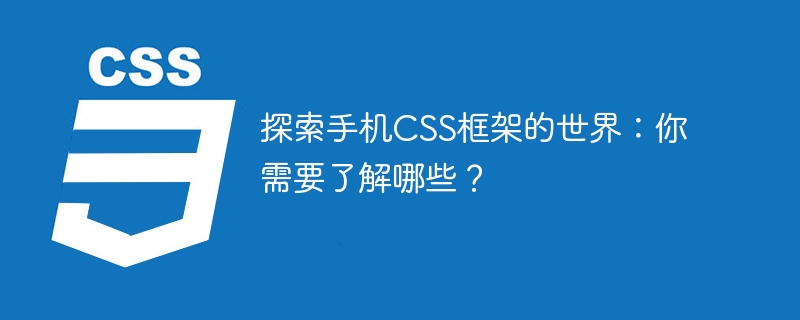Home >Web Front-end >CSS Tutorial >Understanding the mobile CSS framework: the only way to explore mobile interface design

Exploring the world of mobile CSS frameworks: What do you need to know?
In the modern era of mobile devices, mobile CSS frameworks are widely used in web design and development. The mobile CSS framework can simplify the development process, speed up page loading, unify the user experience, and provide better interfaces and responsive designs for mobile devices. This article will explore some commonly used mobile CSS frameworks and provide specific code examples to help readers better understand and apply these frameworks.
1. Bootstrap
Bootstrap is currently one of the most popular mobile CSS frameworks. It provides a complete set of predefined CSS styles and JavaScript components to easily create responsive and beautiful mobile web pages. The following is a simple code example that shows how to use Bootstrap to create a navigation bar:
<!DOCTYPE html>
<html>
<head>
<link rel="stylesheet" href="https://cdn.jsdelivr.net/npm/bootstrap@4.0.0/dist/css/bootstrap.min.css">
</head>
<body>
<nav class="navbar navbar-expand-lg navbar-light bg-light">
<a class="navbar-brand" href="#">Logo</a>
<button class="navbar-toggler" type="button" data-toggle="collapse" data-target="#navbarNav" aria-controls="navbarNav" aria-expanded="false" aria-label="Toggle navigation">
<span class="navbar-toggler-icon"></span>
</button>
<div class="collapse navbar-collapse" id="navbarNav">
<ul class="navbar-nav">
<li class="nav-item active">
<a class="nav-link" href="#">Home</a>
</li>
<li class="nav-item">
<a class="nav-link" href="#">About</a>
</li>
<li class="nav-item">
<a class="nav-link" href="#">Contact</a>
</li>
</ul>
</div>
</nav>
</body>
</html>2. Semantic UI
Semantic UI is another powerful and easy-to-use CSS framework for mobile phones. It provides a series of reusable UI components, allowing developers to create beautiful interfaces through simple class names. The following is an example that shows how to use Semantic UI to create a button:
<!DOCTYPE html>
<html>
<head>
<link rel="stylesheet" href="https://cdnjs.cloudflare.com/ajax/libs/semantic-ui/2.4.1/semantic.min.css">
</head>
<body>
<button class="ui primary button">
Click me
</button>
</body>
</html>3. Foundation
Foundation is a flexible mobile CSS framework that provides a wealth of CSS and JavaScript components to help development Build beautiful mobile pages. The following is an example of a responsive grid layout using the Foundation framework:
<!DOCTYPE html>
<html>
<head>
<link rel="stylesheet" href="https://cdnjs.cloudflare.com/ajax/libs/foundation/6.6.3/css/foundation.min.css">
<style>
.box {
border: 1px solid red;
padding: 10px;
}
</style>
</head>
<body>
<div class="grid-x">
<div class="cell large-4 medium-6 small-12">
<div class="box">
Box 1
</div>
</div>
<div class="cell large-4 medium-6 small-12">
<div class="box">
Box 2
</div>
</div>
<div class="cell large-4 medium-6 small-12">
<div class="box">
Box 3
</div>
</div>
</div>
</body>
</html> 4. Tailwind CSS
Tailwind CSS is a highly customizable mobile CSS framework that provides a large number of practical class names. Unique interface styles can be easily built. The following is a simple example showing how to use Tailwind CSS to create a button:
<!DOCTYPE html>
<html>
<head>
<link href="https://cdn.jsdelivr.net/npm/tailwindcss@1.9.6/dist/tailwind.min.css" rel="stylesheet">
</head>
<body>
<button class="bg-blue-500 hover:bg-blue-700 text-white font-bold py-2 px-4 rounded">
Click me
</button>
</body>
</html>Summary:
The above introduces some commonly used mobile CSS frameworks and provides specific code examples. These frameworks can help developers easily create beautiful and responsive mobile interfaces, greatly improving development efficiency. According to the needs of the project and personal preferences, choosing an appropriate mobile CSS framework can make your webpage appear better on mobile devices. Through further study and practice, you will have a broader vision and better skills in the world of mobile CSS frameworks.
The above is the detailed content of Understanding the mobile CSS framework: the only way to explore mobile interface design. For more information, please follow other related articles on the PHP Chinese website!